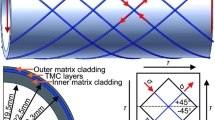Abstract
The analysis of the acoustic signals produced during anterior cruciate ligament (ACL) failure could be useful in understanding its behavior. The purpose of the present study was to evaluate the role of coupling conditions of the sensors and to determine the value of newly introduced acoustic emission (AE) parameters. Seven femur-ACL-tibia complex (FATC) specimens were fixed in a universal tensile testing machine and load was applied. Different coupling conditions were applied in two groups of specimens. The load-time curve was monitored, with the simultaneous recording of the acoustic signals and the failure mode. During ACL tear, detectable changes in the load-time curve occurred linked to changes in the macroscopic sequence of events and the measured AE parameters irrespective the coupling conditions. AE provides information on the determination of the moment (or load) when crucial irreversible damage occurs. Furthermore, specific AE indices exhibit changes throughout the testing, and imply shift of the failure mechanisms.








Similar content being viewed by others
References
Saraf H, Ramesh KT, Lennon AM, Merkle AC, Roberts JC (2007) Measurement of the Dynamic Bulk and Shear Response of Soft Human Tissues. Experimental Mechanics 47:439–449
Zhang D, Nazari A, Soappman M, Bajaj D, Arola D (2007) Methods for examining the fatigue and fracture behavior of hard tissues. Experimental Mechanics 47:325–336
Grosse CU, Finck F (2006) Quantitative evaluation of fracture processes in concrete using signal-based acoustic emission techniques. Cement and Concrete Composites 28:330–336
Shiotani T, Ohtsu M, Ikeda K (2001) Detection and evaluation of AE waves due to rock deformation. Construction and Building Materials 15:235–246
De Rosa IM, Santulli C, Sarasini F (2009) Acoustic emission for monitoring the mechanical behaviour of natural fibre composites: A literature review. Composites Part A 40:1456–1469
Huguet S, Godin N, Gaertner R, Salmon L, Villard D (2002) Use of acoustic emission to identify damage modes in glass fibre reinforced polyester. Composites Science and Technology 62:1433–1444
Kumosa M, Hull D, Price JN (1987) Acoustic emission from stress corrosion cracks in aligned GRP. Journal of Materials Science 22:331–336
Gradin PA, Graham D, Nygård P, Vallen H (2008) The use of acoustic emission monitoring to rank paper materials with respect to their fracture toughness. Experimental Mechanics 48:133–137
Hamstad MA (1986) A review: Acoustic emission, a tool for composite-materials studies. Experimental Mechanics 26:7–13
Browne M, Roques A, Taylor A (2005) The acoustic emission technique in orthopaedics-a review. The Journal of Strain Analysis for Engineering Design 40:59–79
Qi G, Pujol J, Fan Z (2000) 3-D AE visualization of bone-cement fatigue locations. J Biomed Mater Res 52:256–260
Ohtsu M, Tomoda Y (2008) Phenomenological model of corrosion process in reinforced concrete identified by acoustic emission. ACI Materials Journal 105:194–199
Soulioti D, Barkoula NM, Paipetis A, Matikas TE, Shiotani T, Aggelis DG (2009) Acoustic emission behavior of steel fibre reinforced concrete under bending. Construction and Building Materials 23:3532–3536
Shiotani T, Fujii K, Aoki T, Amou K (1994) Evaluation of progressive failure using AE sources and improved b-Value on slope model tests. Progress in Acoustic Emission 7:529–534
Kurz JH, Finck F, Grosse CU, Reinhardt HW (2006) Stress drop and stress redistribution in concrete quantified over time by the b-value analysis. Structural Health Monitoring 5:69
Cormier J, Manoogian S, Bisplinghoff J, Rowson S, Santago A, McNally C, Duma S, Bolte J (2011) The tolerance of the frontal bone to blunt impact. J Biomech Eng 133:021004
Shark L-K, Chen H, Goodacre J (2011) Acoustic emission: a potential biomarker for quantitative assessment of joint ageing and degeneration. Medical Engineering & Physics 33:534–545
Azangwe G, Fraser K, Mathias KJ, Siddiqui AM (2000) In vitro monitoring of rabbit anterior cruciate ligament damage by acoustic emission. Med Eng Phys 22:279–283
Wright TM, Arnoczky SP, Burstein AH (1979) In-situ monitoring of ligament damage in the canine knee by acoustic emission mater. Eval 37:47–58
Kohn DH (1995) Acoustic emission and nondestructive evaluation of biomaterials and tissues. Crit Rev Biomed Eng 23:221–306
Wright TM, Carr JM (1983) Soft tissue attenuation of acoustic emission pulses. J Biomech Eng 105:20–23
Paschos NK, Gartzonikas D, Barkoula NM, Moraiti C, Paipetis A, Matikas TE, Georgoulis AD (2010) Cadaveric study of anterior cruciate ligament failure patterns under uniaxial tension along the ligament. Arthroscopy 26:957–967
Aggelis DG, Paschos NK, Barkoula NM, Paipetis AS, Matikas TE, Georgoulis AD (2011) Rupture of anterior cruciate ligament monitored by acoustic emission. J Acoust Soc Am 129(6):EL217–22
Gabriel MT, Wong EK, Woo SL, Yagi M, Debski RE (2004) Distribution of in situ forces in the anterior cruciate ligament in response to rotatory loads. J Orthop Res 22:85–89
Noyes FR, DeLucas JL, Torvik PJ (1974) Biomechanics of anterior cruciate ligament failure: An analysis of strain-rate sensitivity and mechanisms of failure in primates. J Bone Joint Surg Am 56:236–253
Noyes FR, Grood ES (1976) The strength of the anterior cruciate ligament in humans and rhesus monkeys. J Bone Joint Surg Am 58:1074–1082
Woo SL, Hollis JM, Adams DJ, Lyon RM, Takai S (1991) Tensile properties of the human femur-anterior cruciate ligament-tibia complex. The effects of specimen age and orientation. Am J Sports Med 19:217–225
Wright TM, Vosburgh F, Burstein AH (1981) Permanent deformation of compact bone monitored by acoustic emission. J Biomech 14:405–409
Chen B, Liu J (2004) Experimental study on AE characteristics of three-point-bending concrete beams. Cem Concr Res 34:391–397
Aggelis DG, Shiotani T, Momoki S, Hirama A (2009) Acoustic Emission and ultrasound for damage characterization of concrete elements. ACI Mater J 106:509–514
Author information
Authors and Affiliations
Corresponding author
Rights and permissions
About this article
Cite this article
Paschos, N.K., Aggelis, D.G., Barkoula, NM. et al. An Acoustic Emission Study for Monitoring Anterior Cruciate Ligament Failure Under Tension. Exp Mech 53, 767–774 (2013). https://doi.org/10.1007/s11340-012-9684-3
Received:
Accepted:
Published:
Issue Date:
DOI: https://doi.org/10.1007/s11340-012-9684-3




